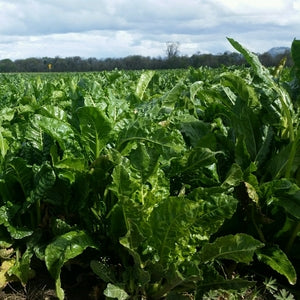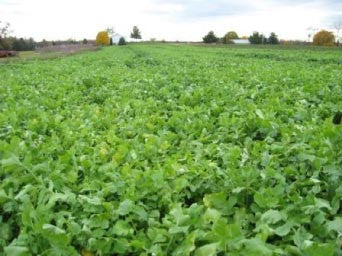SEED CALCULATOR ❌
US Imperial
Metric
Direct Sow
Transplant
=
Number of Plants 0
Weight 0 oz
at 0 seeds per foot

Cover Crop
Certification
Type
Harvest
Specialty
Season
One of the primary uses of cover crops is to increase soil fertility. These types of cover crops are referred to as "green manure." They are used to manage a range of soil macronutrients and micronutrients. Of the various nutrients, the impact that cover crops have on nitrogen management has received the most attention from researchers and farmers, because nitrogen is often the most limiting nutrient in crop production.
Green manure crops are commonly leguminous, meaning they are part of the Fabaceae (pea) family. This family is unique in that all of the species in it set pods, such as bean, lentil, lupins and Alfalfa. Leguminous cover crops are typically high in nitrogen and can often provide the required quantity of nitrogen for crop production. In conventional farming, this nitrogen is typically applied in chemical fertilizer form. This quality of cover crops is called fertilizer replacement value.
Cover crops can also improve soil quality by increasing soil organic matter levels through the input of cover crop biomass over time. Increased soil organic matter enhances soil structure, as well as the water and nutrient holding and buffering capacity of soil.
Although cover crops can perform multiple functions in an agroecosystem simultaneously, they are often grown for the sole purpose of preventing soil erosion. By reducing soil erosion, cover crops often also reduce both the rate and quantity of water that drains off the field, which would normally pose environmental risks to waterways and ecosystems downstream. Cover crop biomass acts as a physical barrier between rainfall and the soil surface, allowing raindrops to steadily trickle down through the soil profile.
Thick cover crop stands often compete well with weeds during the cover crop growth period, and can prevent most germinated weed seeds from completing their life cycle and reproducing. If the cover crop is left on the soil surface rather than incorporated into the soil as a green manure after its growth is terminated, it can form a nearly impenetrable mat. This drastically reduces light transmittance to weed seeds, which in many cases reduces weed seed germination rates.
Green manure crops are commonly leguminous, meaning they are part of the Fabaceae (pea) family. This family is unique in that all of the species in it set pods, such as bean, lentil, lupins and Alfalfa. Leguminous cover crops are typically high in nitrogen and can often provide the required quantity of nitrogen for crop production. In conventional farming, this nitrogen is typically applied in chemical fertilizer form. This quality of cover crops is called fertilizer replacement value.
Cover crops can also improve soil quality by increasing soil organic matter levels through the input of cover crop biomass over time. Increased soil organic matter enhances soil structure, as well as the water and nutrient holding and buffering capacity of soil.
Although cover crops can perform multiple functions in an agroecosystem simultaneously, they are often grown for the sole purpose of preventing soil erosion. By reducing soil erosion, cover crops often also reduce both the rate and quantity of water that drains off the field, which would normally pose environmental risks to waterways and ecosystems downstream. Cover crop biomass acts as a physical barrier between rainfall and the soil surface, allowing raindrops to steadily trickle down through the soil profile.
Thick cover crop stands often compete well with weeds during the cover crop growth period, and can prevent most germinated weed seeds from completing their life cycle and reproducing. If the cover crop is left on the soil surface rather than incorporated into the soil as a green manure after its growth is terminated, it can form a nearly impenetrable mat. This drastically reduces light transmittance to weed seeds, which in many cases reduces weed seed germination rates.
Learn More

-
Price List
One of the primary uses of cover crops is to increase soil fertility. These types of cover crops are referred to as "green manure." They are used to manage a range of soil macronutrients and micronutrients. Of the various nutrients, the impact that cover crops have on nitrogen management has received the most attention from researchers and farmers, because nitrogen is often the most limiting nutrient in crop production.
Green manure crops are commonly leguminous, meaning they are part of the Fabaceae (pea) family. This family is unique in that all of the species in it set pods, such as bean, lentil, lupins and Alfalfa. Leguminous cover crops are typically high in nitrogen and can often provide the required quantity of nitrogen for crop production. In conventional farming, this nitrogen is typically applied in chemical fertilizer form. This quality of cover crops is called fertilizer replacement value.
Cover crops can also improve soil quality by increasing soil organic matter levels through the input of cover crop biomass over time. Increased soil organic matter enhances soil structure, as well as the water and nutrient holding and buffering capacity of soil.
Although cover crops can perform multiple functions in an agroecosystem simultaneously, they are often grown for the sole purpose of preventing soil erosion. By reducing soil erosion, cover crops often also reduce both the rate and quantity of water that drains off the field, which would normally pose environmental risks to waterways and ecosystems downstream. Cover crop biomass acts as a physical barrier between rainfall and the soil surface, allowing raindrops to steadily trickle down through the soil profile.
Thick cover crop stands often compete well with weeds during the cover crop growth period, and can prevent most germinated weed seeds from completing their life cycle and reproducing. If the cover crop is left on the soil surface rather than incorporated into the soil as a green manure after its growth is terminated, it can form a nearly impenetrable mat. This drastically reduces light transmittance to weed seeds, which in many cases reduces weed seed germination rates.
Green manure crops are commonly leguminous, meaning they are part of the Fabaceae (pea) family. This family is unique in that all of the species in it set pods, such as bean, lentil, lupins and Alfalfa. Leguminous cover crops are typically high in nitrogen and can often provide the required quantity of nitrogen for crop production. In conventional farming, this nitrogen is typically applied in chemical fertilizer form. This quality of cover crops is called fertilizer replacement value.
Cover crops can also improve soil quality by increasing soil organic matter levels through the input of cover crop biomass over time. Increased soil organic matter enhances soil structure, as well as the water and nutrient holding and buffering capacity of soil.
Although cover crops can perform multiple functions in an agroecosystem simultaneously, they are often grown for the sole purpose of preventing soil erosion. By reducing soil erosion, cover crops often also reduce both the rate and quantity of water that drains off the field, which would normally pose environmental risks to waterways and ecosystems downstream. Cover crop biomass acts as a physical barrier between rainfall and the soil surface, allowing raindrops to steadily trickle down through the soil profile.
Thick cover crop stands often compete well with weeds during the cover crop growth period, and can prevent most germinated weed seeds from completing their life cycle and reproducing. If the cover crop is left on the soil surface rather than incorporated into the soil as a green manure after its growth is terminated, it can form a nearly impenetrable mat. This drastically reduces light transmittance to weed seeds, which in many cases reduces weed seed germination rates.







